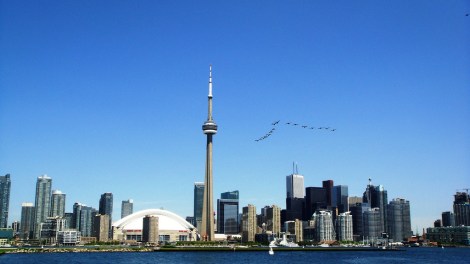Canada’s National Post is an admittedly right-wing newspaper. Proudly right-wing. Cringe-inducingly right-wing.
And so, a special comment the paper ran this morning, titled, “Warmer temperatures would be a benefit, not a problem, for Toronto.” The essay — which the title does an admirable job of summarizing — was written by Lawrence Solomon, who also wrote a book on climate change denial that’s actually called The Deniers. And with that, let’s begin.
In coming decades, climate change will warm Toronto by 5.7 degrees in winter and 3.8 degrees in summer, the city’s parks and environment committee learned in a consultants’ report tabled Tuesday. The consultants, pointing to potentially dire results, indicate that the city may need to spend billions in upgrades. In truth, rising temperatures would be a boon to the city and its taxpayers.
How so? In short: Less snow! Less salt to melt snow! Fewer potholes! Fewer traffic problems! Fewer accidents! More tourists! A word of caution, though: Solomon also suggests that warming may have peaked, remaining unchanged for the last 16 years (this is not true), and that, in fact, in 2014 “we will begin a 40-year-long descent into what will be Earth’s 19th Little Ice Age.” (This is also not true.)

kendoerrToronto, a genuinely lovely city.
It does not escape our notice that most of Solomon’s perks of warmer weather focus on his ability to drive more safely. Nor does it escape our notice that embracing climate change because it means fewer potholes is like embracing being mauled to death by a bear on a wintry tundra because the grizzly’s fur provides shelter from the wind.
Last November, the Toronto Star, a much more sensible newspaper (with double the National Post‘s circulation), ran an article outlining the real threat to Toronto from climate change.
The summer of 2012 was a hot one, preceded by a barely-existent winter. But in 30 years, Torontonians will look back on this as a relatively chilly year, compared with the temperatures being forecast in a dire report from the Toronto Environment Office.
The study predicts triple the number of above-30C days from about 22 on average annually to 66. It forecasts five times as many heat waves in the average summer and it warns that the days when the humidex hits 40C or higher will increase from nine a year to 39 on average. …
“Imagine a summer where for two months the temperature does not go down below 30C. If that were to happen tomorrow there would probably be a significant number of deaths. Our electricity infrastructure would fail. We would have massive blackouts and, who knows what else would happen to the other urban infrastructure? I’m not sure that the city and this administration is taking any of this stuff seriously,” said Franz Hartmann of the Toronto Environmental Alliance.
That may be true, Franz, but: fewer potholes! (Except the ones in which the asphalt buckles due to heat outside the parameters for which the road was built.)
The likely changes the city will see by 2050, as summarized by The Star:
- A 4.4C average annual rise in temperature, including a 5.7C increase in winter and 3.8C in summer.
- The city will see six times as many days when the temperature remains above 24C for 24 hours.
- Slightly more precipitation but with less snow and more rain in the winter. The research forecasts 26 fewer snow days per year.
- Fewer but more extreme rainstorms. The number of winter storms is expected to drop and the number of summer storms remain the same. The amount of rainfall expected in any single day or hour, however, will more than double.
- Heat waves — three or more consecutive days of temperatures above 32C — will increase from 0.57 on average to five a year.
You know what tourists don’t like? Getting deluged with rain and then sweltering through record heat. That is not a fun tourist activity.
Happily, the city has had an action plan in place since 2008 which suggests ways of lessening and avoiding the worst effects of climate change. The question the Star sought to ask wasn’t what was being done, but if what is being done is enough. This is the role responsible media outlets play.
Solomon’s essay is, at its heart, a troll, an attempt to frustrate his opponents and incite anger. Fine. In that respect and that respect only it is a complete success. But one would think he’d be embarrassed by the factual errors (ones so easily debunked) — and even more so by his core argument. “I can’t wait for global warming because winter sucks,” is the first line of attack from a sixth grader who has just discovered the concept and wants to be a contrarian. That’s Solomon’s most fitting audience: immature children who are more interested in showing their uniqueness than giving any thought to how the world is changing around them.


